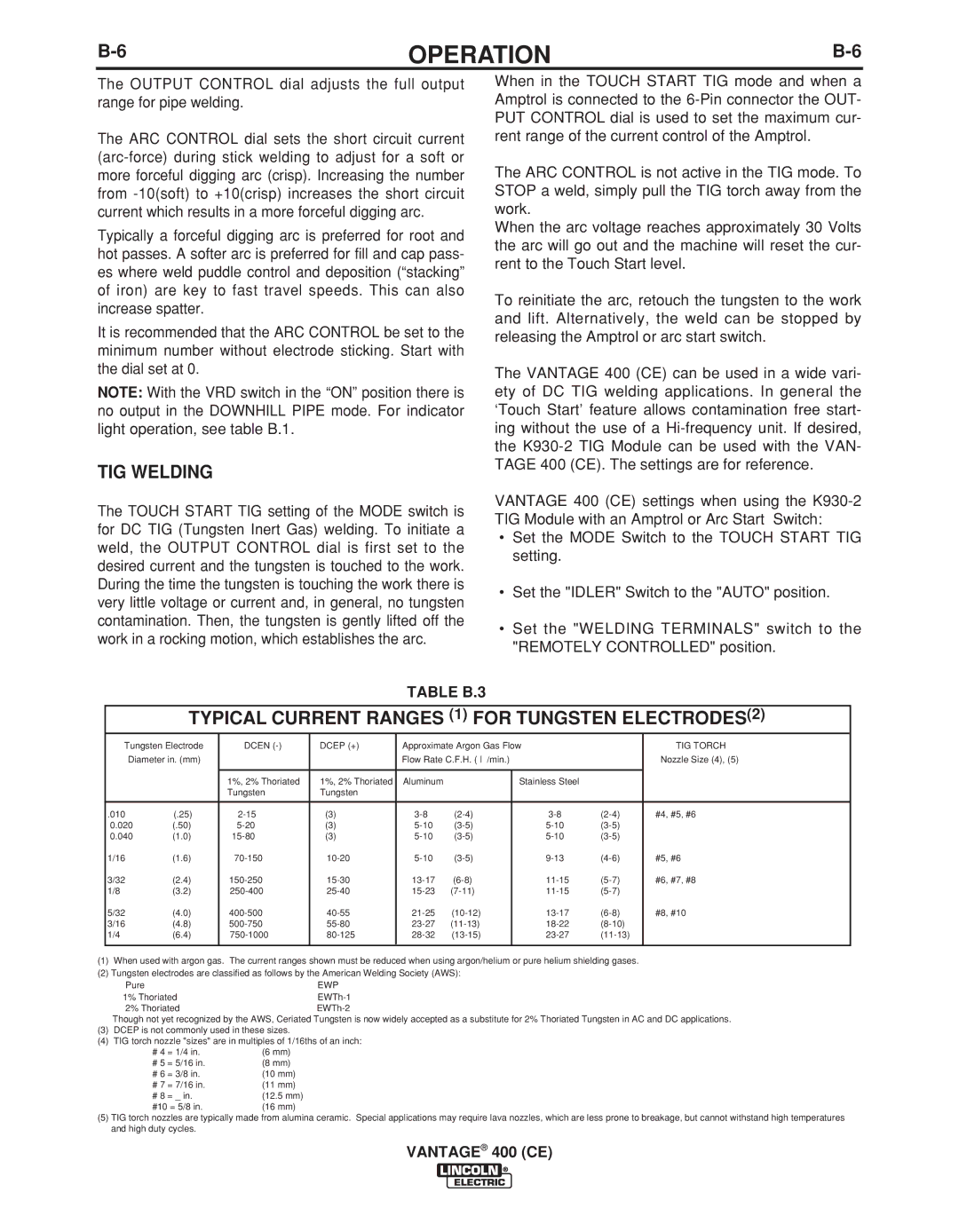
OPERATION |
The OUTPUT CONTROL dial adjusts the full output range for pipe welding.
The ARC CONTROL dial sets the short circuit current
Typically a forceful digging arc is preferred for root and hot passes. A softer arc is preferred for fill and cap pass- es where weld puddle control and deposition (“stacking” of iron) are key to fast travel speeds. This can also increase spatter.
It is recommended that the ARC CONTROL be set to the minimum number without electrode sticking. Start with the dial set at 0.
NOTE: With the VRD switch in the “ON” position there is no output in the DOWNHILL PIPE mode. For indicator light operation, see table B.1.
TIG WELDING
The TOUCH START TIG setting of the MODE switch is for DC TIG (Tungsten Inert Gas) welding. To initiate a weld, the OUTPUT CONTROL dial is first set to the desired current and the tungsten is touched to the work. During the time the tungsten is touching the work there is very little voltage or current and, in general, no tungsten contamination. Then, the tungsten is gently lifted off the work in a rocking motion, which establishes the arc.
When in the TOUCH START TIG mode and when a Amptrol is connected to the
The ARC CONTROL is not active in the TIG mode. To STOP a weld, simply pull the TIG torch away from the work.
When the arc voltage reaches approximately 30 Volts the arc will go out and the machine will reset the cur- rent to the Touch Start level.
To reinitiate the arc, retouch the tungsten to the work and lift. Alternatively, the weld can be stopped by releasing the Amptrol or arc start switch.
The VANTAGE 400 (CE) can be used in a wide vari- ety of DC TIG welding applications. In general the ‘Touch Start’ feature allows contamination free start- ing without the use of a
VANTAGE 400 (CE) settings when using the
•Set the MODE Switch to the TOUCH START TIG setting.
•Set the "IDLER" Switch to the "AUTO" position.
•Set the "WELDING TERMINALS" switch to the "REMOTELY CONTROLLED" position.
TABLE B.3
TYPICAL CURRENT RANGES (1) FOR TUNGSTEN ELECTRODES(2)
Tungsten Electrode | DCEN | DCEP (+) | Approximate Argon Gas Flow |
| TIG TORCH |
| ||||
Diameter in. (mm) |
|
| Flow Rate C.F.H. ( l | /min.) |
| Nozzle Size (4), (5) | ||||
|
|
|
|
|
|
|
|
|
|
|
|
| 1%, 2% Thoriated | 1%, 2% Thoriated | Aluminum |
|
| Stainless Steel |
|
|
|
|
| Tungsten | Tungsten |
|
|
|
|
|
|
|
|
|
|
|
|
|
|
|
|
|
|
.010 | (.25) | (3) |
| #4, #5, #6 |
| |||||
0.020 | (.50) | (3) |
|
|
| |||||
0.040 | (1.0) | (3) |
|
|
| |||||
1/16 | (1.6) |
| #5, #6 |
| ||||||
3/32 | (2.4) |
| #6, #7, #8 |
| ||||||
1/8 | (3.2) |
|
|
| ||||||
5/32 | (4.0) |
| #8, #10 |
| ||||||
3/16 | (4.8) |
|
|
| ||||||
1/4 | (6.4) |
|
|
| ||||||
|
|
|
|
|
|
|
|
|
|
|
(1)When used with argon gas. The current ranges shown must be reduced when using argon/helium or pure helium shielding gases.
(2)Tungsten electrodes are classified as follows by the American Welding Society (AWS):
Pure | EWP |
1% Thoriated | |
2% Thoriated |
Though not yet recognized by the AWS, Ceriated Tungsten is now widely accepted as a substitute for 2% Thoriated Tungsten in AC and DC applications.
(3)DCEP is not commonly used in these sizes.
(4)TIG torch nozzle "sizes" are in multiples of 1/16ths of an inch:
# 4 = 1/4 in. | (6 mm) | |
# 5 | = 5/16 in. | (8 mm) |
# 6 | = 3/8 in. | (10 mm) |
# 7 | = 7/16 in. | (11 mm) |
# 8 | = _ in. | (12.5 mm) |
#10 = 5/8 in. | (16 mm) | |
(5)TIG torch nozzles are typically made from alumina ceramic. Special applications may require lava nozzles, which are less prone to breakage, but cannot withstand high temperatures and high duty cycles.
VANTAGE® 400 (CE)
